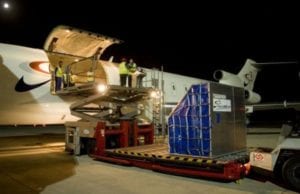Africa has once again impressed with its growth statistics in the recent cargo market analysis for the thrid quarter.
According to a report by the International Air Transport Association (IATA) released in Nairobi on Friday, African airlines transporting freight showed a 10.2 percent increase in demand in August. During the first quarter of the year, the revenue earned from outbound African cargo was $45.8 million, with inbound revenues totaling $333.7 million. “While Africa only contributes 3 percent of the global economy, it is growing the fastest. Some 28 of the 52 countries have 5 percent average economic annual growth and countries like Ghana, Ethiopia, Liberia, Mozambique, Niger and Uganda could potentially grow up to 10 percent,” it said. According to Alan Cassels, Managing Director of DHL Express Equatorial Africa, this positive growth bodes well for business in the region as it translates into economic growth for the continent. Cassels says that the increasing freight volumes in the region can be linked to improved business and consumer confidence as the airline industry performance tracks developments in the global economy.“It is extremely positive that emerging markets such as those in Africa continue to outpace the Western economies and, set against a backdrop of continued global economic uncertainty, job stagnation, a very challenging European environment and a global debt crisis, this shows the continued and increasing importance of Africa,” said Cassels.
He said that the growth in both cargo and freight volumes could be linked to the fact that many businesses, both locally and globally, are looking to Africa for expansion and with the new discoveries of gas and oil fields in Southern and Central Africa, coupled with the technology and healthcare boom, there is an expected improvement in regional trade expansion. The IATA Cargo Market Analysis report pointed to an increase in the number of air freight routes between Africa and the Middle East, with the highest rate of 17.9 percent recorded in February. In contrast, the route between Europe and the Middle East only showed 1.4 percent growth over the same period. “Sub-Saharan Africa undoubtedly provides numerous opportunities for both SMEs looking to reach out globally, and international companies looking to expand,” Cassels said, cautioning however against complacency. “However, there are still numerous challenges around infrastructure, labor relations and the ease of trade within the region which need very urgent attention.”







